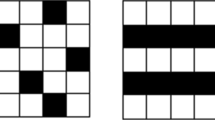Abstract
This paper proposes a new temporal error concealment algorithm in H.264 video sequences based on scene change detection and PCA model. In order to detect scene change, dynamic threshold and image similarity metric are presented using coding prediction mode and DCT AC energy in H.264 baseline. UPCA (Updated PCA) model is presented by combining the scene change feature with Index transformation-Buffer updating approach. The lost images are concealed by Projection onto Convex Sets algorithm with UPCA model. Experimental results show that the proposed algorithm can achieve better error concealment performance for the higher motion and the frequent scene change, compared with the related method.






Similar content being viewed by others
References
Ameigeiras P, Navarro-Ortiz J, Andres-Maldonado P et al (2016) 3GPP QoS-based scheduling framework for LTE. EURASIP J Wirel Commun Netw 78:78
Behar R, Samet Y, Nossenson R (2015) Session management of variable video rate streaming session over multi-channel networks. In: 7th international conference on evolving internet, pp 26–33
Bo Y, Ng KW (2004) A novel motion vector recovery algorithm for error concealment in video transmission. Consumer Commun Netw Conference:621–623
Brandt J, Trotzky J, Wolf L (2008) Fast frame-based scene change detection in the compressed domain for MPEG-4 video. In: Second international conference on next generation M o b i l e applications, services, and technologies NGMAST’09[c], pp 514–520
Chen T, Zhang X, Shi Y-Q (2003) Error concealment using refined boundary matching algorithm, information technology. Res Education:55–59
Chen TP-C, Chen T (2002) Second-generation error concealment for video transport over error-prone channels. Wiley Wireless Commun M o b i l e Comput 6(2):607–624
De Bruyne S, De Neve W, De Wolf K, De Schrijver D, Van de Verhoeve P (2007) Temporal video segmentation on H.264 compressed bit streams. Advances in Multimedia Modeling. MMM2007. Springer, Singapore, pp 1–12
Dehghani M, Arshad K, MacKenzie R (2015) LTE-advanced radio access enhancements, a survey. Wireless Pers Commun 80:891–921
H.264 Software Coordination JM Software, ver. 15.0, 2009,1: http://iphome.hhi.de/suehring/tml
Lam WM, Reibman AR, Liu B (1993) Recovery of lost or erroneously received motion vectors. ICASSP-93 4:417–420
Li H, Liu G, Zhang Z, Li Y (2004) Adaptive scene detection algorithm for VBR video stream. IEEE Trans Multimed 6(4):624–633
Li X, Orchard MT (2002) Novel sequential error-concealment techniques using orientation adaptive interpolation. IEEE Trans Circuit Syst Video Technol 10 (12):854–864
Nemethova O (2007) Error resilient transmission of video streaming over wireless mobile networks. Technische Universit at Wien Osterreich 3:77–88
Xie X, Zaitsev Y (2014) Scalable, MEMS-enabled, vibrational tactile actuators for high resolution tactile displays. JMM 24(12):11
Xie X, Zaitsev Y et al (2014) Compact, scalable, high-resolution, MEMS-enabled tactile displays. In: Proceedings of solid-state sensors, actuators, and microsystems workshop, June 8-12, pp 127–130
Yu G, Li Z, Wang S-Y, Shen L-S (2010) A GOP level video scene change detection algorithm in H.264 compression domain. Chinese J Electron 38(2):382–386
Zeng W, Gao W (2005) Shot change detection on H.264 compressed video. In: IEEE international symposium oil circuits and systems, Kobe, Japan. IEEE, pp 3459–3462
Zhou L (2015) Mobile device-to-device video distribution: theory and application. Journal ACM Transactions on Multi-media Computing, Communications and Applications (ToMM) 12(3):1253– 1271
Zhou L, Wang XB, Wei T, Muntean G-M, Geller B (2010) Distributed scheduling scheme for video streaming over multi-channel multi-radio multi-hop wireless networks. IEEE J Selected Areas in Commun 28(3):409–419
Author information
Authors and Affiliations
Corresponding author
Rights and permissions
About this article
Cite this article
Choe, G., Nam, C. & Chu, C. An effective temporal error concealment in H.264 video sequences based on scene change detection-PCA model. Multimed Tools Appl 77, 31953–31967 (2018). https://doi.org/10.1007/s11042-018-6184-1
Received:
Revised:
Accepted:
Published:
Issue Date:
DOI: https://doi.org/10.1007/s11042-018-6184-1




